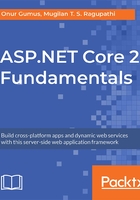
上QQ阅读APP看书,第一时间看更新
Introduction to ASP.NET
ASP.NET is a server-side web application development framework, developed by Microsoft, allowing developers to build web applications, websites, and web services.
It is currently fully open source in this URL and is still maintained by Microsoft: https://github.com/aspnet
Basically, ASP.NET has three main programming models: ASP.NET Web Forms, ASP.NET MVC, and ASP.NET Web Pages. They form part of the ASP.NET Framework in this manner:
- ASP.NET for .NET Framework: This has the following sub sections:
- Web Forms: This is known for rapid application development. This tries to mimic desktop behavior.
- MVC: This applies the Model-View-Controller pattern.
- Web API: This is an MVC-style web service.
- Single-Page Application: Here, the server gives the initial HTML request, but further rendering happens entirely within the browser.
- ASP.NET Core: It is the new ASP.NET Platform that runs in a cross-platform manner. Subsections are:
- Web API: This is primarily used for developing web services.
- Web Application: This is used for MVC Applications. It can be used for developing web services too. Web API and MVC have become an almost unified thing.
- Web Application (Razor Pages): Razor Pages is a feature of ASP.NET Core MVC that makes coding page-focused scenarios easier and more productive.
A recent trend for developers is the use of Single-Page Application frameworks on top of web services like Web APIs. However, MVC and Single-Page Application frameworks also play nicely together. In the future, we expect Microsoft to put more effort on .NET Core instead of .NET Framework. .NET Framework is already mature. Perhaps it will be put into maintenance mode but nothing is certain yet.
Even though the end result of all of the preceding programming models is to produce dynamic web pages effectively, the methodologies that they follow differ from each other. Let us discuss ASP.NET MVC.